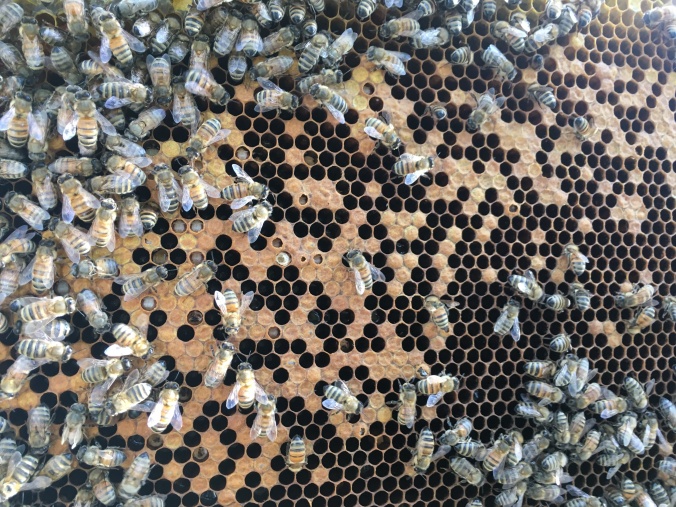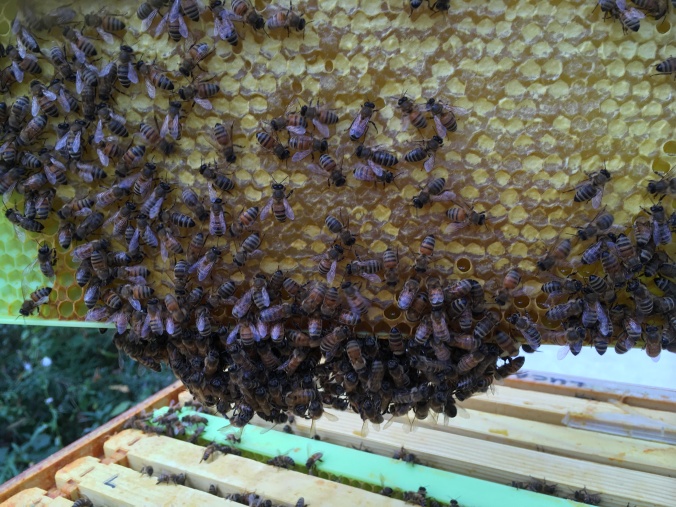As you read this, please be sure to read the updates to get a true picture of what’s happening in our hive.
If there were a scale called “Chances Our Bees Will Survive the Winter,” it might look like this:
1__________________________________5_____________________________10
Bees will certainly die. Bees might not die. Bees will certainly live.
Following the Yellow Jacket raid two weeks ago, I would have put our girls at about 1.5.
After this week’s hive inspection, however, I think they’re closer to a 3, perhaps even a 3.5.
They have some brood. It’s spotty, but I think that may be normal with winter approaching. I know the queen slows down on laying eggs this time of year so there are less mouths to feed during winter. And we have baby bees hatching and some larvae. We also spotted the queen, which is always reassuring. 
The caps on the cells aren’t as nice as earlier in the season, which was a bit worrying, so we checked for American Foulbrood (AFB) this week. The larvae in the caps we opened weren’t discolored and didn’t “rope out,” so we don’t have to burn all our equipment.
Yes, AFB is that bad. Its spores can live up to 70 years on equipment, and it’s lethal. (Click the link, and the Ontario Ministry of Agriculture, Food and Rural Affairs will tell you all about the disease.)
So, no burning necessary. That’s a relief.
Update: Sassafras Bee Farm very kindly sent me an email with some bad news. Our bees almost certainly have Parasitic Mite Syndrome (PMS). Here’s a link to some information on this syndrome, with lots of pictures that look exactly like our hive.
This week, there’s also been a great deal of wrestling going on in front of the hive, with bees dragging other bees out of the hive and dropping them on the ground, sometimes even flying away with them (to drop them elsewhere, I guess).
At first, we thought the hive was being raided … again, and our bees were protecting the hive — another worry. But our girls weren’t stinging the bees they tossed out.
It reminded me of that scene in Monty Python and the Holy Grail. You know, “I’m not dead yet!”
If you haven’t seen it, click the link above for the clip.
I’ll wait.
Funny, eh?
I can be a little dense, but eventually I realized what was happening. The worker bees were getting rid of the drones. They didn’t need to sting the evicted bees because drones don’t have a stinger and can’t sting back.
As you may know, drones don’t do much except fly to a Drone Congregation Area (DCA) and hang around, hoping to mate with a queen. (I’ve linked to Honeybee Suite here, partly for the description of DCAs and partly because I liked the comments.) There’s at least one DCA in England that is documented as having been in the same place for centuries.
Here’s a blog post from a guy who went in search of one that was written about in the late 1700s.
He found it too. Pretty amazing, if you ask me!
The mating process breaks a drone in two.
At least they go out with a bang. (Sorry!)
Since drones take up valuable resources with no immediate benefits to their hive, a hive won’t create male bees until it can support them.
But who makes that decision?
Not the queen. Her job is laying eggs, and she does so according to the size of the cell — fertilized for workers in smaller cells, unfertilized for drones in larger cells.
Not the drones. We’ve established that they’re only good for one thing. (And I’m not, repeat not, drawing conclusions about any other species based on bees!)
So who decides the size of the cells? The worker bees.
And don’t they deserve that privilege? They’re called workers for a reason, and it’s a simple one. They do all the work.
Okay, okay, the queen labors too. Spending your life laying eggs and then being made to swarm or being killed by a usurper is work too. “Uneasy lies the head that wears a crown,” and all that.
But, I digress.
Back to the workers. Guess what? They also chose when to create queen cells and raise new queens when they deem it time to swarm or replace the old queen.
Talk about the power of the sisterhood!
The boys? Not so much power. If a drone doesn’t mate by the time fall comes around, he’s kicked to the curb. His sisters quit feeding him, making him weak, and all that much easier to wrestle out of his home.
Judging by the state of the wings of some of the drones we saw on the ground, I think the girls may chew the wings of their bros, as well.
Yeah. It’s a rough life for a bee. Workers work themselves to death. Drones mate and die or get kicked from their hive and die. Queens lay eggs their whole life, and then are killed or forced to swarm (and then die later).
So, let’s change the subject and look at some pictures.
 The Engineer took this picture of a showdown. I’m pretty sure it’s a worker making sure a drone doesn’t come back in the hive. Drones are usually bigger than worker bees, which isn’t the case here, but their eyes are also much bigger. This is more obvious in the picture below. The blog, Gerry’s Bees, has a nice picture showing the usual differences. Update: Sassafras Bee kindly pointed out that the big-eyed bee is NOT a drone, but a worker with Deformed Wing Virus.
The Engineer took this picture of a showdown. I’m pretty sure it’s a worker making sure a drone doesn’t come back in the hive. Drones are usually bigger than worker bees, which isn’t the case here, but their eyes are also much bigger. This is more obvious in the picture below. The blog, Gerry’s Bees, has a nice picture showing the usual differences. Update: Sassafras Bee kindly pointed out that the big-eyed bee is NOT a drone, but a worker with Deformed Wing Virus. 
In the seven days since our last inspection, the bees also produced a lot more honey. 
It’s so beautiful; I couldn’t stop taking pictures


This last picture is of the honey they’ve made on one of the drone foundations we put in last month to try to help with the Varroa infestation. The queen laid a few drones on it, but the next time we checked the hive, our bees were saving nectar in both drone frames. We left them in, and now they are full of honey.
Notice on the bottom of the picture there are bees hanging off one another in sort of a cluster. They frequently do this between frames as we remove the frames to inspect, clinging to each other in a living bee chain until the distance becomes so great they are forced to let go. The phenomenon is called “festooning,” and here’s a great photo of what it looks like (from Honeybee Suite).
The Engineer and I have been working too, learning what we can do to aid our girls in getting through winter. Yesterday, we attended an all-day class on “The Hardest Season.” We came away with a much longer “to-do list” than we went in with.
And now, I’m cautiously, infinitesimally, almost imperceptibly hopeful we can help — or at very least, not hinder — their chances of survival.
On a scale of one to ten, I’d give us a 4, mostly for effort. 🙂
Update: While I’d still give us a 4 for effort, I’m not sure anything we do will save our hive. We may be starting fresh in spring. Feeling down about this, and there’s nothing slight, cautious, or infinitesimal about the emotion.
“Drones go out with a bang…” Oh, beehave! Still, I’m really glad there are tiny hopeful signs, and you’ll be doubly alert in future after this scare.
LikeLiked by 1 person
Sorry, Kate. I couldn’t resist. The life of a bee is not easy, nor are the decisions of a beekeeper simple.
LikeLike
I’m in a poor position to object, given my own continuous stream of puns… 🙂
LikeLiked by 1 person
Kate, an experienced beekeeper pointed out several errors in what I thought about our bees. They are in trouble, and it’s so sad to feel perhaps we may have made mistakes that contributed to this state. Looking back, however, I have to say the learning curve is steep, and we’ve done the best we knew how. Maybe next year will be better. Sorry to offload on you. Just needed to tell someone.
LikeLike
Take comfort. At least you know you have a lot to learn and are anxious to do better, instead of shrugging, saying “well, they’re only insects” and moving on to the next new shiny thing.
LikeLiked by 1 person
The picture of that poor drone with the chewed up wings is too sad for me to even look at. Can’t do it.
LikeLiked by 1 person
Actually, it turns out he is not a he, but a worker with Deformed Wing Virus, part of Parasitic Mite Syndrome, which is actually worse news. But we will persevere — feeding, treating, and hoping against hope they will recover. If they don’t, we start again next year in a better place with drawn comb and honey for a new package of bees. We won’t give up unless our bees do. I was fooled by the size of the eyes, even though I know drones are supposed to be bigger.
LikeLike
Pingback: Minding our Bees and Qs | The Byrd and the Bees